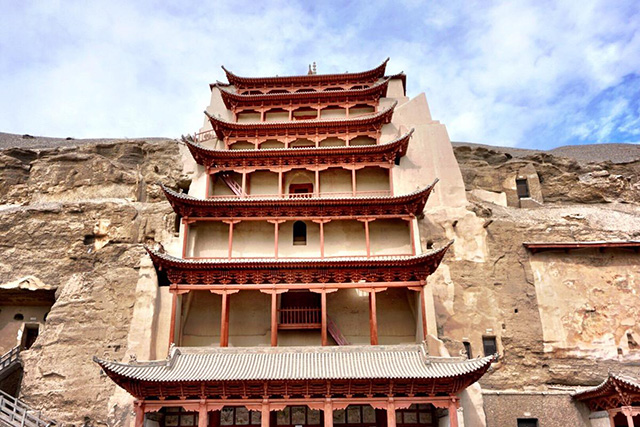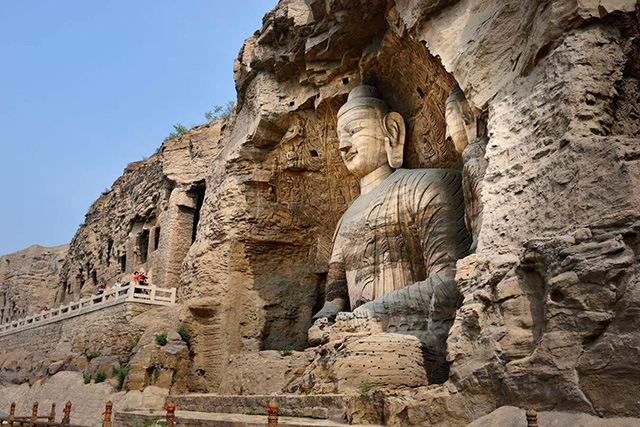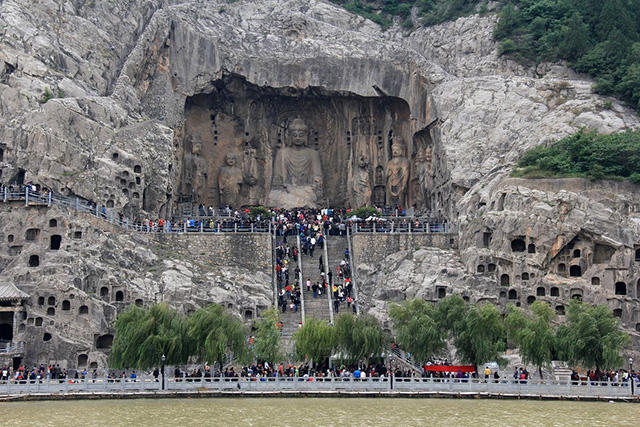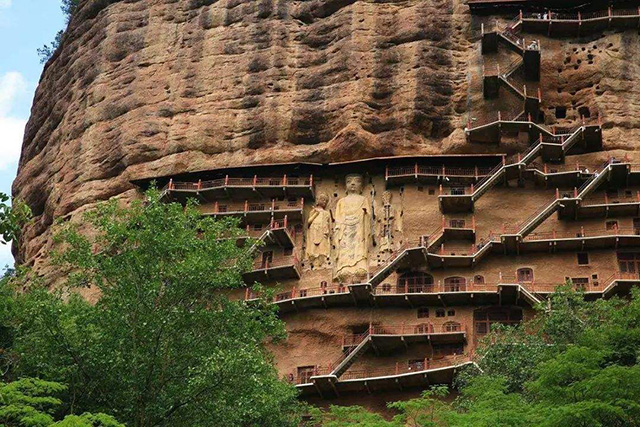The four major grottoes refer to the giant cave art landscape featuring Chinese Buddhist culture, including: Mogao Grottoes (Dunhuang, Gansu), Yungang Grottoes (Datong, Shanxi), Longmen Grottoes (Luoyang, Henan), Maijishan Grottoes (Tianshui, Gansu) ) Is a historical gem of ancient Chinese traditional culture and art.
1.Mogao Grottoes 莫高窟

Also known as “Thousand Buddha Caves”, it is located 25 kilometers southeast of Dunhuang City, on the west bank of the Daquangou Riverbed, on the cliff at the east foot of Mingsha, and is one of the four treasure houses of art in China. In the second year of the pre-Qin Fujian period (AD 366), there were Shamen Le Venerables who came here. Seeing the golden light on the Mingsha Mountain, there were thousands of Buddhas, so they germinated and digged their hearts.
2.Yungang Grottoes 云冈石窟

The Yungang Grottoes are located at the southern foot of Wuzhou Mountain, 16 kilometers west of Datong City in Shanxi Province in northern China. The grotto was carved in the second year of Xing’an in the Northern Wei Dynasty (AD 453), most of it was completed before the Northern Wei moved to Luoyang (AD 494). The grotto is chiseled against the mountain, and the east and west stretch for about 1 km. It is magnificent and rich in content. There are 45 main caves, 252 large and small niches, and more than 51,000 stone statues. The largest is 17 meters, and the smallest is only a few centimeters. The images of Bodhisattva, Lux and Feitian in the cave are vivid and lively. The carvings on the tower are exquisite and delicate. The first in color, together with Dunhuang Mogao Grottoes in Gansu and Longmen Grottoes in Henan, is also called “Three Great Grottoes in China”, and is also one of the world-famous treasure trove of stone carving art. There are forty-five major caves with more than 51,000 statues in size. It is one of the largest ancient grotto groups in China. In 1961, the State Council announced it as a national key cultural relics protection unit.
3.Longmen Grottoes 龙门石窟

Longmen Grottos, located 12 kilometers south of Luoyang city, is one of the four largest grottoes in China that is synonymous with Maijishan Grottoes, Datong Yungang Grottoes, and Dunhuang Qianfo Cave Grottoes.
Longmen is a beautiful place, where there are two green mountains facing east and west, and the Iraqi water flows slowly northward. From a distance, it looks like a natural door, so it was called “Yi Que” in ancient times. Now “Yi Que” has become the first landscape of Youlongmen since ancient times. The Tang poet Bai Juyi once said: “The victory of Luoyang’s four outskirts of mountains and rivers is the first of Longmen.”
The Longmen Grottoes were excavated around the Northern Wei Dynasty when Emperor Xiaowen moved his capital to Luoyang (AD 494). It has a history of more than 1,500 years. Later, after going through the Eastern and Western Wei Dynasty, the Northern Qi Dynasty, the Northern Zhou Dynasty, and the Sui, Tang, and Song dynasties, it was continuously constructed on a large scale for more than 400 years. It is densely covered on the cliffs of the east and west mountains of Yishui. It is more than 1,000 meters long from north to south. There are more than 1,300 existing grottoes, 2,345 Buddhist caves and shrines, more than 50 stupas, and more than 100,000 Buddha statues. The largest Buddha statue is 17.14 meters high and the smallest is only 2 centimeters. In addition, there are more than 3,600 inscriptions and inscriptions on the statues of the past dynasties, all of which reflect the high artistic attainments of the working people in ancient China. Among them4., Binyang Middle Cave, Fengxian Temple and Guyang Cave are the most representative.
The Longmen Grottoes in Luoyang, Henan are located in the southeast of Luoyang City. They are distributed on the cliffs on both sides of the Yishui River. The Longmen Grottoes were built in the Northern Wei Dynasty and have been built for more than 400 years. There are more than 2,300 existing shrines and more than 100,000 statues. It is a model of ancient Chinese carving art.
4.Maijishan Grottoes 麦积山石窟

The Maiji Mountain Grottoes are located on a lone peak in the West Qinling Mountains on the southern side of Maijishan Township, 50 kilometers southeast of Tianshui City, Gansu Province. The Maiji Mountain Grottoes were founded in the Qin Dynasty (AD 384 to 417) after the Sixteen Kingdoms, and have been repaired and expanded afterwards. The Sui Dynasty was basically completed by the end of the sixth century and remains intact.
Maiji Mountain Scenic Area covers an area of 215 square kilometers, including Maiji Mountain, Xianren Cliff, Shimen, Quxi four scenic spots and Jieting Ancient Town. Maiji Mountain Grottoes is a national key cultural relics protection unit, a national civilized scenic tourist area demonstration site, and also a world-renowned art treasure house, known as the Oriental Sculpture Museum. On June 22, 2014, Maijishan successfully applied for a legacy.